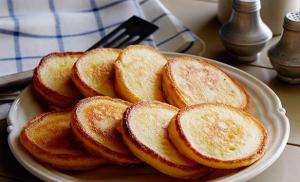Life in fresh waters and the world around us 4. Life in fresh water bodies




















Enable Effects
1 of 21
Disable effects
View similar
Embed code
VKontakte
Classmates
Telegram
Reviews
Add your review
Abstract for the presentation
The presentation “The Life of a Freshwater Body” tells students in a playful way about the flora and fauna of the planet’s freshwater bodies. A description of birds, insects, animals, fish, above-water and underwater plants, etc. is provided. Each species has a photograph and a riddle.
- Crossword;
- Pond plants;
- The importance of plants in water bodies;
- Animals of water bodies;
- Underwater inhabitants of reservoirs;
- Insects.
To conduct a lesson by a teacher
Format
pptx (powerpoint)
Number of slides
Shaveleva O.A.
Audience
Words
Abstract
Present
Purpose
Slide 1
Slide 2
Water lily
A water lily lies on a leaf,
Like on an elastic raft,
And I would float down the river
To friendly friends,
But here's the problem: the raft is tied -
He won't float anywhere.
Slide 3
Crossword
Slide 4
Lake
Slide 5
Pond plants
Slide 6
Duckweed
Duckweed thickets consist of many individual flat oval-shaped cakes smaller than a fingernail. Duckweed is a flowering plant. But it blooms extremely rarely. Its flowers are so small that they are difficult to see with the naked eye.
Slide 7
Kubyshka
Egg lily flower
Slide 8
White water lily
White water lily
Slide 9
Series
A series of trees grows on the banks of the reservoir
Slide 10
Arrowhead
Arrowhead
Slide 11
Seaweed
Slide 12
Plants of ponds
Slide 13
Cancers
People live under water
Walks backwards.
Slide 14
Heron
Long thin beak
Grabs the frog -
A drop drips from the beak.
Who is this?..
Slide 15
Fish
She had a saw in her mouth.
She lived under water.
Scared everyone, swallowed everyone,
And now she’s fallen into the cauldron.
Slide 16
Beavers
Water masters
They build a house without an axe,
House of brushwood and mud
And a dam.
Slide 17
Som
At the bottom, where it is quiet and dark,
A mustachioed log lies.
Slide 18
Snail
Who has eyes on horns,
And the house on the back?
Slide 19
Dragonfly
Blue airplane
Sat on a white dandelion.
Slide 20
Duck
Pied Quack
Catches frogs
Waddles around -
Stumbled.
Slide 21
Internet sources
http://site/
View all slides
Abstract
Lesson on the world around us
Goals:
Lesson progress
A water lily lies on a leaf,
Like on an elastic raft,
And I would float down the river
To friendly friends,
But here's the problem: the raft is tied -
He won't float anywhere. ( slide 2)
Teacher.
Students.
Teacher.
The teacher conducts a survey:
– How does a meadow differ from a forest?
(slide 3)
Questions for the crossword:
- Runs among the stones
You can't keep up with her.
He grabbed the tail, but - ah! –
She ran away with the tail in her hands.
Teacher.
III. Working on a new topic.
Slide 4
Teacher.
Students.
Teacher. (showing photos)
The teacher opens the diagram: (slide 5)
duckweed (slide 6)
Flower egg pods is located at the end of a long peduncle, which grows from a rhizome lying at the bottom of a reservoir. The leaves of the plant are large, dense, rounded-heart-shaped with a glossy surface. (slide 7)
White water lily has a thick rhizome at the bottom of the reservoir. The flowers are pure white with a pleasant delicate aroma. They float to the surface early in the morning and open up. By evening they close again and hide under the water. And if bad weather approaches, the flowers either do not appear from the water at all, or hide ahead of time. (slide 8)
Grows on the banks of the reservoir series. This medicinal plant with thorny seeds that cling to clothing. (slide 9)
Arrowhead can be recognized by the leaves, which look like arrows with large, wide tips. The plant reaches a height of one meter. (slide 10)
Susak umbrella
Plants of ponds:
Algae floats in the water column. Plants wholly submerged in water receive oxygen for respiration and carbon dioxide to create organic matter from water. (slide 11)
Students.
Teacher.
(slide 13-20)
People live under water
Walks backwards. (Cancer.)
Long thin beak
Grabs the frog -
A drop drips from the beak.
Who is this?.. (Heron.)
She had a saw in her mouth.
She lived under water.
Scared everyone, swallowed everyone,
And now she’s fallen into the cauldron. (Pike.)
Water masters
They build a house without an axe,
House of brushwood and mud
And a dam. (Beavers.)
At the bottom, where it is quiet and dark,
A mustachioed log lies. (Som.)
Who has eyes on horns,
And the house on the back? (Snail.)
Blue airplane
Sat on a white dandelion. (Dragonfly.)
Pied Quack
Catches frogs
Waddles around -
Stumbled. (Duck.)
Students.
Teacher. Who are tadpoles?
Students.
Teacher.
Students.
Look here.
The water splashes quietly,
Duckweed, lily, cattail,
Both the egg capsule and the reed.
There is a toothless one, a pond snail,
The water strider is running.
The catfish lies on the bottom.
Teacher.
plants - crucian carp - pike;
Students.
Teacher.
Students.
Teacher.
Students.
4) Find an extra name:
Homework.
Lesson on the world around us
Goals:
- To form students’ understanding of the life of a freshwater body.
- Introduce the diversity of the inhabitants of the reservoir, their relationships.
- Formulate rules of conduct aimed at protecting the inhabitants of the reservoir.
- Develop students' cognitive interest.
Equipment: presentation “Life of a fresh water body”; herbarium; drawings and photographs depicting plants and animals of fresh water.
Lesson progress
I. Organizational moment. Communicate the topic and objectives of the lesson.
A water lily lies on a leaf,
Like on an elastic raft,
And I would float down the river
To friendly friends,
But here's the problem: the raft is tied -
He won't float anywhere. ( slide 2)
Teacher. What natural community is this poem about? Where did we just go?
Students. This poem talks about a river.
Teacher. Today in the lesson we will get acquainted with the diversity of flora and fauna of fresh water. Let's find out how they are related to each other.
II. Checking homework.
The teacher conducts a survey:
– How does a meadow differ from a forest?
– What living creatures are found in the meadow?
– Why is a meadow called a natural community?
– Give examples of ecological connections of meadows.
The teacher offers to solve the crossword puzzle and read keywords. (slide 3)
Questions for the crossword:
- It flutters over the flower, dances, and waves its patterned fan.
- This meadow insect chirps loudly, unnoticed in the green grass.
- This meadow dweller has a raspy voice.
- This bird sings “drink-weed” loudly.
- This bird constantly shakes its tail.
- A bright blue and fluffy flower in a meadow, not fragrant.
- This plant is recognized by its small triangular fruits that look like bags.
- Runs among the stones
You can't keep up with her.
He grabbed the tail, but - ah! –
She ran away with the tail in her hands. - This is a very valuable cereal - a fodder plant with thin leaves and small spikelets forming a panicle.
- This meadow resident is an orderly, eats carrion, and buries dead animals in the ground for its larvae.
- An amphibian that can be found in the meadow.
- This insect was named after the doctor - the hero of Greek myths. Currently this is a rare animal.
Teacher. Meadows adorn our region, and it is very important to protect them. How do people use meadows? Why do grasslands need protection? Why can't you set fire to old grass?
III. Working on a new topic.
Slide 4
Teacher. Today we are going to the shore of a fresh reservoir. What bodies of water are called fresh?
Students. River, lake, stream, pond, canal, reservoir.
Teacher. You have repeatedly observed bodies of water. When you come to a lake, pond, or river, only some of its inhabitants are visible. It is impossible to see everyone. But there are a lot of them! A body of water is a place where a wide variety of living things live. (showing photos). Here are the plants: cattail, reed, reed, arrowhead, egg capsule, water lily, duckweed, various algae. Here are the animals: fish, frogs, snails, various insects: dragonflies, water strider bug, etc.
Let's get to know them better.
The teacher opens the diagram: (slide 5)
The flora of the reservoir is very rich. Some plants grow in the pond itself, while others grow on the shore. If you look at the surface of the reservoir, you can see that it is covered with small green leaves. This is a plant duckweed. Duckweed thickets consist of many individual flat oval-shaped cakes smaller than a fingernail. Duckweed is a flowering plant. But it blooms extremely rarely. Its flowers are so small that they are difficult to see with the naked eye. (slide 6)
Flower egg pods is located at the end of a long peduncle, which grows from a rhizome lying at the bottom of a reservoir. The leaves of the plant are large, dense, rounded-heart-shaped with a glossy surface. (slide 7)
White water lily has a thick rhizome at the bottom of the reservoir. The flowers are pure white with a pleasant delicate aroma. They float to the surface early in the morning and open up. By evening they close again and hide under the water. And if bad weather approaches, the flowers either do not appear from the water at all, or hide ahead of time. (slide 8)
Grows on the banks of the reservoir series. This is a medicinal plant with thorny seeds that cling to clothing. (slide 9)
Arrowhead can be recognized by the leaves, which look like arrows with large, wide tips. The plant reaches a height of one meter. (slide 10)
Susak umbrella attracts attention with beautiful white-pink flowers collected in a loose inflorescence at the top of the stem. Susak leaves are very narrow, long, straight. They are collected in a bunch and rise up from the base of the stem.
Plants of ponds:
1 – iris; 2 – whitewing; 3 – cotton grass; 4 – arrowhead; 5 – reeds; 6 – cattail; 7 – egg capsule; 8 – duckweed; 9 – white water lily; 10 – pinnate; 11 – elodea
Algae floats in the water column. Entirely submerged plants receive oxygen to breathe and carbon dioxide to create organic matter from the water. (slide 11)
What role do plants play in a body of water?
Students. Plants produce oxygen and provide homes and food for animals.
Students make a diagram about the role of plants in a pond. (slide 12)
Teacher. As already mentioned, various animals also live in shallow bodies of water: frogs, fish, insects.
You already know many animals well. Try to guess them. (slide 13-20)
People live under water
Walks backwards. (Cancer.)
Long thin beak
Grabs the frog -
A drop drips from the beak.
Who is this?.. (Heron.)
She had a saw in her mouth.
She lived under water.
Scared everyone, swallowed everyone,
And now she’s fallen into the cauldron. (Pike.)
Water masters
They build a house without an axe,
House of brushwood and mud
And a dam. (Beavers.)
At the bottom, where it is quiet and dark,
A mustachioed log lies. (Som.)
Who has eyes on horns,
And the house on the back? (Snail.)
Blue airplane
Sat on a white dandelion. (Dragonfly.)
Pied Quack
Catches frogs
Waddles around -
Stumbled. (Duck.)
The teacher suggests looking at the illustration “Fresh Reservoir” on p. 192–193 of the textbook and find which animals have not yet been named.
Students. Swimming beetle, water strider bug, crucian carp, bivalves, tadpoles, pond snail, reel.
Students read the text on p. 195 textbook.
Teacher. Who are tadpoles?
Students. Tadpoles are baby frogs and toads that are born from eggs and at first look very much like small fish.
Teacher. Carefully and quietly approaching the reservoir, we will see water strider bugs gliding along the surface in jerks. Their paws are covered with fine hairs that are lubricated with fat. Therefore, water striders do not drown, but move freely through the water. The water strider bug is a predator. It catches mosquito larvae, attacks insects, plunges its sharp proboscis into the body of the insect and quickly sucks out its victim.
Insects and their larvae, aquatic plants serve as food for fish.
Name what predators live in bodies of water.
Students. Heron, water strider, pike, swimming beetle, frogs.
Students do the exercises for the teacher.
Look here.
The water splashes quietly,
Duckweed, lily, cattail,
Both the egg capsule and the reed.
There is a toothless one, a pond snail,
The water strider is running.
The catfish lies on the bottom.
Teacher. Explain how the plants and animals of a pond are related to each other. Make power chains.
plants - crucian carp - pike;
plants - tadpoles - ducks.
Students. Plants and animals live together. Plants release oxygen into the water, which animals breathe. Many animals feed on the plants of the pond. Tadpoles eat algae, and ducks eat tadpoles.
This means that a fresh body of water is a natural community.
Teacher. Very often a person causes damage to a body of water. Read the article “If a person intervenes...” on p. 196–198 textbook. What troubles did man bring to the pond?
Students. The destruction of bivalves made the water cloudy, and this threatened the existence of many plants and animals. Fishing has led to an increase in the number of diseased fish.
Teacher. How should a person behave in order not to disturb the ecological balance in a reservoir?
Students. There is no need to catch orderly crayfish and filter mollusks. Do not destroy tadpoles and frogs - there will be a lot of mosquitoes and midges. It is necessary to protect the rare plants of the reservoir: white water lilies and egg capsules.
IV. Consolidation of the studied material.
- Make 2-3 food chains that have developed in a reservoir.
- Task “Think!” us. 198 textbook.
- Make a diagram of “Animals of the reservoir.”
4) Find an extra name:
a) cattail, duckweed, arrowhead, birch;
b) beaver, toad, otter, muskrat;
c) water striders, swimming beetles, crucian carp, mosquito;
d) crucian carp, pike, catfish, dolphin.
V. Summing up the lesson. Grading.
Students read the conclusion on p. 199 textbook.
Homework.
pp. 191–200. Answers to "Test Yourself" questions.
To answer the question: should swamps be protected?






















 Back Forward
Back Forward
Attention! Slide previews are for informational purposes only and may not represent all of the presentation's features. If you are interested in this work, please download the full version.
Goals: to form students’ ideas about the life of a freshwater body of water; introduce the flora and fauna of freshwater bodies of water; formulate rules of conduct aimed at protecting the inhabitants of the reservoir.
Equipment: computer, multimedia projector, textbook “The world around us, grade 4, part 1” by A.A. Pleshakova, E.A. Kryuchkova, “Workbook”, atlas-identifier, tables with images of plants and animals of water bodies, map of the Primorsky Territory.
Lesson progress
I. Organizational moment.
II. Updating basic knowledge.
1. Conversation.
Why is a meadow called a natural community? ( Give examples).
Give examples of ecological connections of meadows.
Questions for the crossword:
Moved by the flower
All four petals.
I wanted to rip it off -
He took off and flew away. (Butterfly)
From the branch to the path,
From blade of grass to blade of grass
The spring jumps -
Green back. ( Grasshopper)
He lives in the meadow
And he calls me to sleep all the time!
- Drink and drink, it’s time to sleep!
So until the morning!
Who knows such a bird?
Who will guess the riddle? ( Quail)
That bird is shaking its tail
And there are bugs on the ground.
She lives where there is water,
You will recognize her without difficulty! ( Wagtail)
Like a blue light
Someone suddenly lit it in the rye.
Bright wildflower.
What is this? ( Knapweed)
This plant is recognized by its small triangular fruits that look like bags. ( Shepherd's Purse)
Fast and nimble
I'm in a snake's skin,
And you'll catch me by the tail,
You'll lose it right away. ( Lizard)
This is a very valuable cereal - a fodder plant with thin leaves and small spikelets forming a panicle. ( Bluegrass)
Warm day, spring, May
Everyone will know about me.
I'm not a fly, not a spider.
I'm buzzing! I am May... ( bug)
He sits with his eyes bulging,
He speaks French
Jumps like a flea
Swims like a human. ( Frog)
This insect was named after the doctor - the hero of Greek myths. Currently, this is a rare animal. ( Swallowtail)
Read the keywords. ( Take care of the meadows)
3. Check task 7 on page 81 of the “Workbook”.
Which conventional signs drew on the topic “How to behave in the meadow”?
Exhibition of drawings of conventional signs. Repetition of rules of conduct in the meadow.
III. Self-determination for activity.
Read the poem and add the last word.
The water splashes quietly,
Duckweed, lilies, cattails,
And the egg capsule and the reed,
There is a toothless one, a pond snail,
The water strider is running -
Life is in full swing in him.
This is a fresh... (reservoir).
What will we talk about in class?
What would you like to know about this topic?
IV. Working on new material.
1. Conversation.
What is a pond?
- A reservoir is a place where water is collected or stored.
- Remember that bodies of water are divided into two groups based on their origin. Which? ( Reservoirs can be natural or artificial. There are salty and fresh.)
- What bodies of water will we talk about in class? ( About fresh)
- What fresh water bodies do we have in the Primorsky Territory?
2. Show on the map.
Types of reservoirs.
Which of these reservoirs are natural and which are artificial?
What plants can be found in ponds? On the banks of ponds?
Complete task 1 on page 82 of the Workbook.
Examination. What interesting things did you learn?
What plant is found in the reservoirs of our region, but is not mentioned in the textbook? ( Lotus)
4. What role do plants play in the life of reservoirs?
The role of plants in the life of a reservoir.
- Animal house
- They release oxygen necessary for organisms to breathe.
- Food for animals.
5. Independent work.
According to the drawing on pages 180-181, get acquainted with the living organisms of fresh water bodies.
Who can be seen on the surface of the water?
In the water column?
At the bottom of a pond?
Slides 8-9.
Guess the riddles.
Pied Quack
Catches frogs
Walks waddle-
Stumbled. ( Duck)
Underwater
People live
Walks backwards
Forward. ( Cancer)
For parents and children
All clothes are made from coins. ( Fish)
At the bottom, where it is quiet and dark,
A mustachioed log lies. ( Som)
Blue airplane
Sat on a white dandelion. ( Dragonfly)
They build a house without an axe,
A house without brushwood and mud
And a dam. ( Beavers)
Who has eyes on horns,
And the house is on the back. ( Snail)
V. Generalization of knowledge.
Who lives where
On the surface of the water
-> plants: egg capsule, cattail (roots in water), duckweed, water lilies
-> insects: water strider bug, swimming beetles
In the water column
-> tadpoles of frogs and toads
-> different types fish
-> algae
-> shellfish: pearl barley, pond snail, reel
-> crayfish
Associated with bodies of water
-> birds: ducks, herons
-> mammals: beavers, water rats, otters
Conclusion on the studied material.
We learned that a body of water is a natural community. Everything in it is interconnected. Plants and animals die. Dead remains rot and are destroyed under the influence of microorganisms. Salts are formed, and plants use them for growth. Animals, in turn, feed on plants.
But man interferes in the life of this community, tears up rare plants, catches orderly crayfish, and destroys tadpoles and frogs. To avoid an environmental disaster, you need to learn to appreciate life in all its manifestations.
VI. Additional material“Fresh reservoirs of our region”
Lake Khanka, Razdolnaya River.
Slides 13-18.
Lake Khanka.
- Location: Far East
- Height: 68-70 m
- Area: 4070 km?
- Volume: 18.3 km?
- Greatest depth: 10.6 m
- Average depth: 4.5 m
- Catchment area: 16,980 km?
- Flowing rivers: Lefou, Melgunovka, Sintukha, etc.
- Outflowing river: Sungacha
Slides 19-21.
Razdolnaya River.
- The Razdolnaya River flows through Russia and China.
- The source is the confluence of the rivers: Xiaosuifenhe and Dasuifenhe.
- Mouth: Amur Bay of the Sea of Japan.
- Length: 245 km
- Basin area: 16,830 km?
VII. Drawing up a memo “Man by the water”
- Don’t tear up egg pods, water lilies, lotuses!
- Do not catch crayfish, bivalves, or dragonflies!
- Don't destroy animals' homes!
- Take care of frogs and tadpoles!
- Help adults protect animals in water bodies!
- Do not throw garbage into the water or on the banks of reservoirs!
- Not my bike and others vehicles on the banks of reservoirs!
VIII. Summing up the lesson.
What was the purpose of the lesson?
What knowledge have you gained?
IX. Reflection.
Complete the sentence: “Now I know that...”
Who can I thank for the lesson?
X. Homework.
- Read the text on pages 178-186 of the textbook.
- Complete tasks 5-7 of the “Workbook”.
- Examine fresh water plants in the herbarium. Identify them using the atlas-identifier.
- Using the drawing, get acquainted with the living organisms of fresh waters. Try naming them yourself first, covering them with a strip of signature paper, and then test yourself.

1. Mallard duck: female (a) and male (b). 2. Beaver, his dam and hut. 3. Reed. 4. Water strider bug. 5. Swimming beetle. 6. Crucian carp. 7. Bivalves. 8. Crayfish. 9. Microscopic green algae. 10. Reed. 11. Heron. 12. Arrow leaf. 13. Rogoz. 14. Egg pods. 15. Frog. 16. Water lily. 17. Pike. 18. Tadpoles. 19. Coil. 20. Elodea. 21. Prudovik.

- Use this drawing to teach about ecological connections in fresh waters.
Natural freshwater community
Living organisms of fresh water (plants, animals, bacteria) form a natural community.
Some plants (cattail, reed, reed, arrowhead) are attached to the bottom with their roots, and the stems and leaves of these plants rise above the water. The roots of egg capsules and water lilies are also at the bottom, and their wide leaves float on the surface. But there are also plants that do not attach to the bottom at all. This is, for example, duckweed that floats on the surface of the water. And tiny (microscopic) green algae float in the water column. They can only be seen under a microscope. But sometimes there are so many of them that the water appears green.
The role of plants in the aquatic community is great. They serve as food for animals and release oxygen into the water, which is necessary for the respiration of organisms. Underwater thickets of plants serve as a refuge for animals.
Let's watch the animals. Water strider bugs are quickly running along the surface of the water. Their long legs are covered with fat below, and therefore water striders do not drown. They are predators, hunting mosquitoes and other small animals.
Swimming in the water column are predatory swimming beetles, herbivorous tadpoles of frogs and toads, and various types of fish, such as crucian carp and pike.

Crucian carp feeds on plants and insect larvae. Pike is a predatory fish.
Crayfish live at the bottom. They feed on the remains of dead animals. Bivalves also live on the bottom. Their soft body is protected by a shell, which consists of two valves. These mollusks feed very interestingly. They absorb and pass water through their body, which contains algae and other small living creatures.
Other mollusks live on aquatic plants - the herbivorous pond snails and coil snails. They have curled shells.

The life of many birds, such as ducks and herons, is also connected with water. Mammals also live near the water - beaver, muskrat, water rat, otter. You can find information about them and images of these animals in the identification atlas.
In the freshwater community, as in other communities, the cycle of substances occurs. When plants and animals die, their remains fall to the bottom. Here, under the influence of bacteria, the dead remains rot and are destroyed.
Salts are formed from them. These salts dissolve in water and can then be used to feed the plant.
Man by the water
You already know how water pollution harms all living things. But this is not the only thing we should think about.
Many beautiful, interesting plants and animals living in fresh waters or on the shores require special protection. Let's not tear egg capsules and water lilies, catch crayfish, bivalves, dragonflies! Let's not destroy the homes of muskrats and beavers! Let's take care of frogs and tadpoles!
In winter, under the ice, fish often lack oxygen. It is necessary to make holes in the ice so that oxygen can enter the water. You can participate in this work, but be sure to do it together with adults, because being on the ice can sometimes be dangerous. In the spring, take part in another work - saving young fish. The fact is that after the spring flood in different places puddles remain. They usually contain a lot of fish fry. They are in danger of dying when the puddles dry up. To save the fry, the guys catch them and transfer them in jars or buckets to safe places.
- Based on your observations, tell us what freshwater plants and animals are found in your region.
- Build a model of a food chain typical of the freshwater community in your region. Ask your deskmate to check your work. If necessary, correct the error by modifying the model.
- Describe the freshwater community in your region.
Let's discuss!
- The names of which plants and animals indicate their life in water?
- How are various plants and animals adapted to life in and near water?
- If frogs disappear, how will this affect mosquitoes and herons? What could cause frogs to disappear?
Test yourself
- What living organisms make up the freshwater community?
- Which freshwater plants and animals require special protection?
- What kind of work to protect aquatic life can schoolchildren participate in?
Homework assignments
- During the warm season, make observations near a river, lake or pond. Use the atlas-identifier. Perhaps you will be able to listen to frog concerts, see how a swimming beetle rises to the surface of the water to breathe, how a water strider bug runs through the water, how a heron looks out for its prey. These observations will give you many new discoveries and vivid impressions.
- In the book “Green Pages” read the chapter about beavers. What ecological connections are revealed in this chapter? Give examples. What did you find most interesting from this chapter? Prepare a message.
- In the book “The Giant in the Clearing,” read the stories “Take care of the crayfish!” and “Why are shells needed in the river.” Have you ever encountered cases similar to those described in the stories? What do you think about this?
Nature's pain
Should swamps be protected?
When people learned to drain swamps, they began to do it without thinking about the consequences. And it is not surprising: after all, people considered swamps to be an unnecessary and even harmful part of nature.
But now it has become clear that this is not so.
Swamps are wonderful natural reservoirs of water; many rivers originate from them! In addition, swamps, like huge filters, purify the water. Passing through dense thickets of mosses and grasses, through a thick layer of peat, the water in the swamps is freed from dust, harmful substances, pathogenic bacteria. The purest water flows into the rivers from the swamps!
Wetlands are home to many species of plants and animals. That's amazing carnivorous plant sundew. Its leaves are covered with hairs, at the ends of which droplets of sticky juice glisten, similar to drops of dew. This attracts insects. The insect lands on a leaf and... sticks. The leaf closes and the insect is digested in droplets of juice. This is how the sundew receives additional nutrition.
Here's a cranberry. The berries of this plant are tasty and healing. But due to drainage, there are fewer and fewer swamps where cranberries grow. Cranes, herons, waders find food in the swamps, make nests...
So think about the consequences of excessive drainage of swamps.
Next lesson
Let's learn about the work of plant growers in our region. We will learn to distinguish between branches of crop production and relate varieties of cultivated plants to them.
Remember what sectors agriculture is divided into. What crops are grown in your region?
Fresh water life
PLACE OF WORK: MKOU PYANKOVSKAYA OOSH
SVERDLOVSK REGION
The world around us 4th grade. School of Russia. Pleshakov A.A.
Topic: Life of fresh water
Target: to form students’ ideas about fresh water as a natural community.
Tasks
educational:
introduce the diversity of living organisms in fresh water bodies and the role of humans;
developing:
develop children’s cognitive activity, interest, ability to observe, compare, generalize and draw conclusions;
educational:
teach children to understand the beauty of fresh water;
cultivate love careful attitude to the nature of his native land.
Formed UUD:
Cognitive – identify the known and the unknown, realize the cognitive task, read, extract necessary information;
Communication – participate in the general conversation, observing the rules of speech behavior;
Regulatory – act according to plan, monitor the process and results of activities, make the necessary adjustments, adequately evaluate your achievements;
Personal – acquire new knowledge and skills
Lesson progress
I. Org. moment(1 min.)
We will start the lesson with a warm-up
We straighten our backs.
They stretched on their toes,
Turned right left
And they smiled at each other.
One, two, three, four, five
It's time for us to start our lesson.
II. Updating of reference knowledge
1. Test(on cards)(5 min.)
Slide No. 1-6
1. The following grow in the meadow:
A) only herbaceous plants
B) mosses and lichens
B) shrubs and herbaceous plants
2. They live in the meadow:
A) swans, hazel grouse, silkworms
B) bumblebees, owls, wood grouse
B) wagtails, dung beetles, fillies
3. Meadow plants are:
A) timothy, clover, cornflower
B) lily of the valley, sedge, moss
C) blueberry, peony, fescue
4. Meadows and forests are called nurses:
A) dung beetles and gravedigger beetles, woodpeckers
B) bees, wild boars, jays
C) ground beetles, grasshoppers, bark beetles
5. What food chains are typical for the meadow community?
A) acorns→mice→owls
B) bluegrass→mice→owls
C) plant remains→earthworm→wagtail
Key: 1 – a, 2 – c, 3 – a, 4 – a, 5 – b, c
2. Messages, crosswords, food chains(5 min.)
III. Self-determination for activity(5 min.)
Look at the screen. (labeled on the screen – river, lake, pond, forest)
Slide No. 8
Eliminate unnecessary illustrations.
Justify your answer. (The forest is land, the rest is water) I believe that...... (remove the forest)
How to call the remaining objects of nature in one word. (Water)
- What will we talk about in class? (About life in bodies of water.)
Slide No. 9
What lesson goal can be set in connection with the topic? ( Learn about animals and plants in bodies of water and their relationships.)
What will we do to achieve this goal? ( We will work from a textbook, in a notebook, with a key atlas, in groups, in pairs, we will reason, draw conclusions, prove our point of view.)
What would you like to know about this topic? Formulate your questions.
I write it down on the board.
IV. Discovery of new knowledge
1. Conversation.(2 min.)
Let us remember that reservoirs are divided into two groups based on their origin. Which? (Natural and artificial)
What about the composition of the water? (fresh and salted.)
What types of fresh water bodies can you name? (river, lake, stream, canal, pond, reservoir)
2. Work in groups(10 min.)
Today we will have three editorial departments of the Life of Fresh Water magazine.
Game conditions:
We will divide the class into three sections.
Each department receives a task card.
All employees must actively participate in the discussion of all issues and prepare a report on the work of the department in the form of a poster.
Cards are distributed, children are divided into 3 sections:
1 department works on the topic “Plants of the reservoir”
Department 2 works on the topic “Animals of the reservoir”
Department 3 works on the topic “Man and the body of water”
| Card No. 2 Find out: Name the animals of the reservoir. Animals of the pond |
| Card No. 3 Find out: Human |
Fizminutka
Report of departments on the work done(6 min.)
– Is fresh water- community? Prove it. (Plants release oxygen into the water, which animals breathe. Crucian carp feed on plants and insect larvae, and pike feed on crucian carp).
You've done a good job, now let's apply what we've learned.
V. Incorporation of new knowledge into the knowledge system
1. Modeling.In pairs(3 min.)
Using the illustrations on p. 180-181, write down 2-3 power chains characteristic of a fresh water body (notebook p. 84 No. 6).
EXAMINATION
2. Assignments in a notebook.On one's own(3 min.)
EXAMINATION
VI. Summing up the lesson(2 min.)
WHAT WAS THE PURPOSE OF THE LESSON?
WHAT KNOWLEDGE HAVE WE DISCOVERED TODAY?
WHERE CAN I APPLY NEW KNOWLEDGE?
HAVE WE ANSWERED ALL THE QUESTIONS posed at the beginning of the lesson?
VII. Reflection(2 min.)
COMPLETE THE SENTENCE: “Now I know that...”
What did you do well in the lesson?
Grading.
VIII. Homework(differentiated) (1 min.)
To choose from:
A message about the plants and animals of the reservoir from the Red Book of our region.
Illustrate the food chains characteristic of a freshwater body.
Create a crossword puzzle “The life of a pond”
Application
| Card No. 2 Work plan for department 2 “Water animals” Find out: Name the animals of the reservoir. Is the body of water rich in animal diversity? (Make a diagram of “Animals of the reservoir”) Animals of the pond Peculiarities of life of some animals of the reservoir. |
| Card No. 3 Work plan of the 3rd department “Man and the Reservoir” Find out: The importance of fresh water bodies for humans. (In diagram form) Human What human actions can lead to disruption of the ecological balance of a reservoir? Make rules for behavior near water. (The rules may be in the drawings.) |
Test
FI _________________________
Grade
Test
FI _________________________
Grade
Test
FI _________________________
Grade
Test
FI _________________________
Grade
Test
FI _________________________
Grade
Test
FI _________________________
THE WORLD AROUND UMK "School of Russia" 4th grade MBOU secondary school s. Talitsa teacher primary classes Bulavina Irina Anatolevna
Meadow - natural community
Game "Get to know me"
Life in fresh waters
Lesson objectives: to get acquainted with the flora and fauna of fresh water bodies; consider ecological connections in a freshwater community; determine the role of humans in the life of water bodies.
FRESH RESERVOIR Natural Artificial RIVER LAKE CREEK CANAL POND RESERVOIR
cattail reed Plants of ponds
Water Lily Capsule
Duckweed Arrowhead
Seaweed
PHYSICAL MINUTE
1. Exercises to improve cerebral circulation “Head tilts” Forward - backward Right - left
2. Exercises to relieve fatigue from the shoulder girdle and arms “Clenching the hand into a fist”
3. Exercise to relieve tension from the muscles of the torso “Bends to the side”
Fauna of fresh water bodies
Food chains duckweed algae duck tadpoles pike crucian carp mosquito frog heron
Man by the water
Rules of human behavior near water Do not throw household waste into water bodies! Clear the springs, springs! Do not tear the egg capsule or water lily - they are listed in the Red Book! Take care of all pond plants! Do not catch reels and pond snails for fun! Let's take care of frogs and tadpoles! In winter, make holes in the ice so the fish can breathe! Don't catch crayfish or bivalves! Don't destroy the homes of beavers and muskrats!
bodies of water! Take care and protect
A freshwater body is a natural community, because all the inhabitants of the reservoir live together and are connected by a food network.
Reflection Complete the sentence: “Now I know that...” Select a statement about our lesson Nothing is clear in the lesson. Everything is clear in the lesson, there are no difficulties. I want to know more.
Homework Read the text pp. 178-184, prepare a story about the freshwater community according to the plan on p. 165 In the workbook, complete tasks 2, 8 on pp. 82-85 Read the article “Should we protect swamps?” pp.185-186













